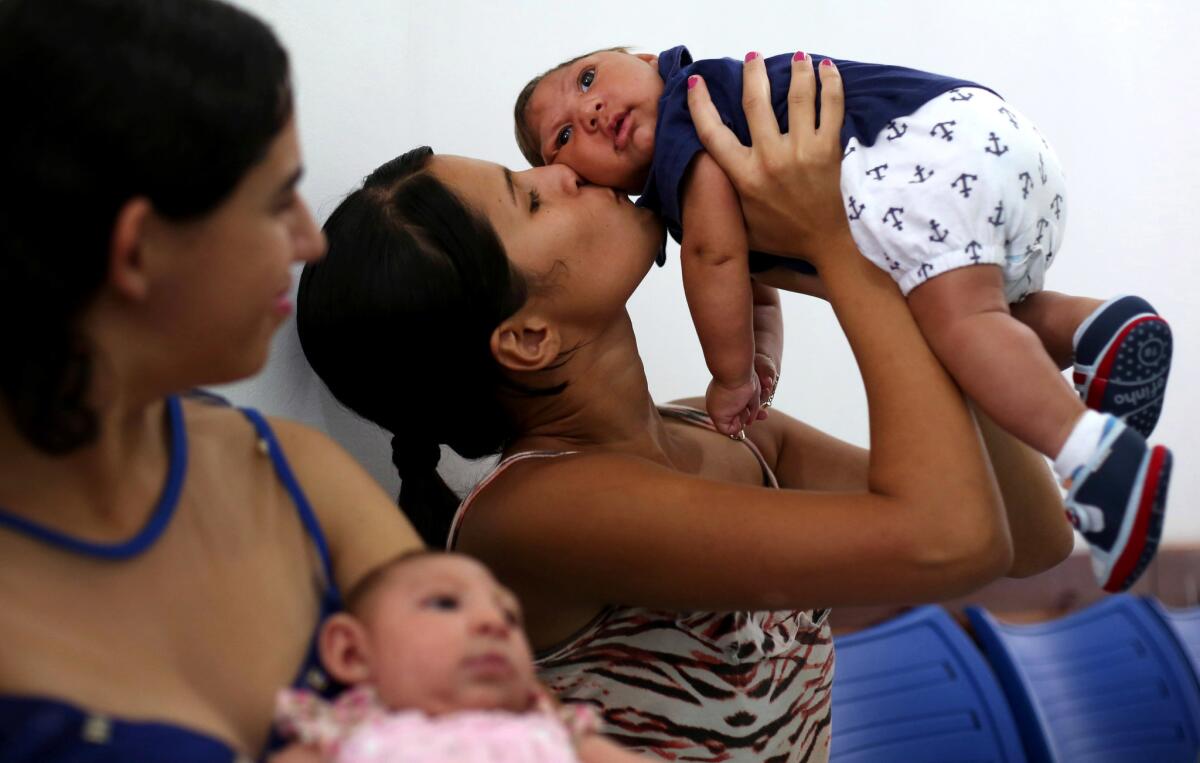For Zika-exposed babies, trouble may emerge in their first year

The Centers for Disease Control and Prevention has found that in their first year of life, 14% of babies exposed to Zika before birth had one or more health problems likely caused by the mosquito-borne virus. And for some of those babies, the toll of that gestational exposure was not evident at birth, the U.S. public health agency revealed.
Microcephaly — a smaller-than-usual head size -- has emerged as a hallmark of Zika exposure in babies. But in many babies whose mothers were infected by the Zika virus during pregnancy, follow-up care revealed health issues that were less immediately evident, including brain and eye damage, vision and hearing abnormalities and nervous system problems such as seizures.
Many of those babies had appeared healthy at birth, and only as the babies grew older did those abnormalities become evident.
The rate of congenital abnormalities that are known to be caused by Zika virus infection (including microcephaly and eye damage) is roughly 30 times higher than would normally be seen in a population not exposed to the virus, the CDC said. That number could rise as experts establish that Zika is the clear cause of many of the less evident abnormalities seen among the babies, the authors of the new CDC report added.
“We expect to learn more as these children grow and develop and additional problems are diagnosed,” said Peggy Honein, who directs the CDC’s Division of Congenital and Developmental Disorders. “As we learn more, we are likely to identify additional children with health problems. So the Zika story is not over and we have so much more to learn.”
Those findings emerged from an analysis of 1,450 infants born in U.S. territories and freely associated states (including American Samoa, Federated States of Micronesia, Marshall Islands, Puerto Rico and the U.S. Virgin Islands) between 2016 and early 2017, and who were tracked for at least a year after birth. Those babies were among some 4,800 children confirmed to have been exposed in utero and who are now being tracked by the CDC. All of the tracked pregnancies in the U.S. Zika Pregnancy and Infant Registry (USZPIR) occurred between 2016 and 2018.
The CDC says that in 2018, it has found no evidence of local mosquito-borne Zika virus transmission in the continental United States. The last confirmed cases of local mosquito-borne transmission in the U.S. were in Florida and Texas, where two and five cases, respectively, were reported in 2017.
Zika is still a threat internationally, however, and the health agency recommends that women who are pregnant should not travel to a long list of countries in Africa, Asia, the Caribbean and Central and South America, where mosquitoes are still transmitting the Zika virus. That list also includes Mexico and the U.S. territory of Puerto Rico.
U.S. officials reported that roughly 74 cases of local mosquito-borne transmission have been confirmed in 2018 in Puerto Rico.
The new figures offer a clearer picture of Zika’s toll in cases where a woman carrying a developing fetus is infected by Zika, either because she was bitten by a virus-bearing mosquito or because she has had unprotected sex with a man infected in the last three months.
On Tuesday, the CDC also unveiled new recommendations aimed at preventing the sexual transmission of the Zika virus. The agency had previously recommended that men infected with the virus abstain from sex or use a condom during sex for six months after they have shown symptoms of infection, including fever, rash, conjunctivitis and joint or muscle pain. It now says such protections are necessary for three months only.
Honein said that the new findings do not offer further clarity on how the timing of Zika infection during pregnancy affects a baby’s health. While exposure during the first trimester of pregnancy appears to pose the greatest danger to a fetus, she said abnormalities were seen in babies born to mothers infected later in pregnancy as well.
“We’re still learning more every day about the full impact” of the virus, Honein said on Tuesday.
Of the 4,165 Zika-affected pregnancies that make up the CDC’s study population, seven infants were excluded who reportedly died before reaching their first birthday. Three of those babies died during the first 14 days of life.
Honein said the full picture of Zika’s effects would be clearer if more of the babies born to Zika-infected mothers had undergone a complete battery of recommended tests after birth. Among the study’s 1,450 children, only three-quarters had at least one developmental screening or evaluation, and 60% underwent recommended brain scanning after birth. Fewer than half were evaluated for hearing problems, and just 36% underwent a vision evaluation.
That level of follow-up care came despite the fact that the children’s outcomes were a subject of study, despite recommendations that full evaluations should be performed on all Zika-affected babies, and despite solid evidence that prompt action can make a difference in a baby with neurodevelopmental problems.
In cases where vision or hearing problems are identified, for instance, corrective eyeglasses or hearing aides might boost a child’s developmental prospects. But those conditions might go undetected if a Zika-affected child has no signs of microcephaly at birth.
Brain scans or vision evaluation can detect such abnormalities in time to make a difference, Honein said Tuesday.
“Because the full spectrum of adverse outcomes related to congenital Zika virus infection is not yet known, careful monitoring and evaluation of children born to mothers with laboratory evidence of confirmed or possible Zika virus infection during pregnancy is essential for ensuring early detection of possible disabilities and early referral to intervention services that might improve outcomes,” the authors of the new study wrote.
MORE IN SCIENCE




